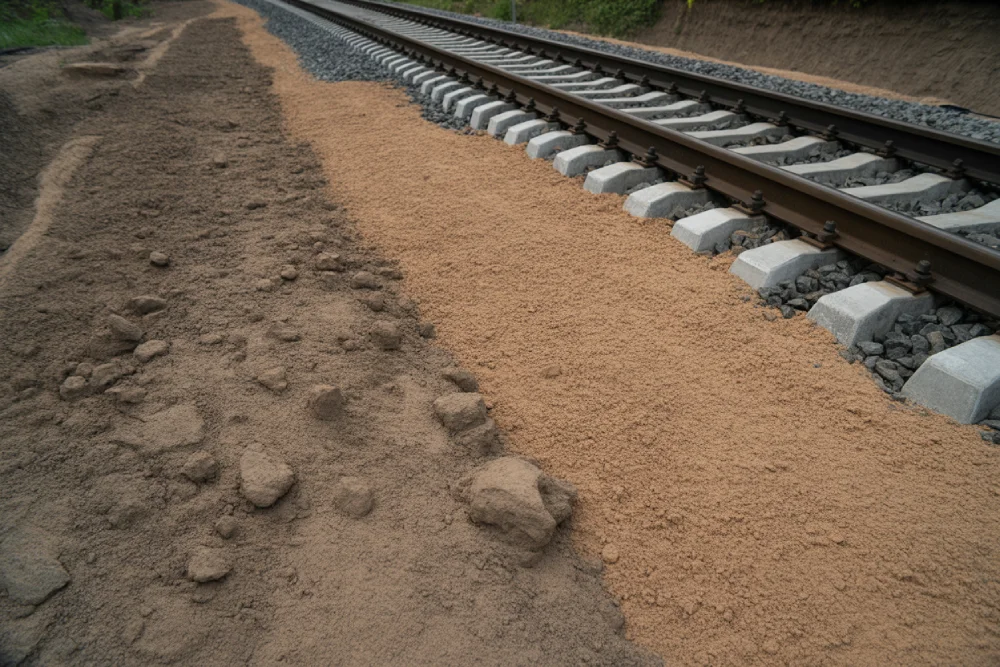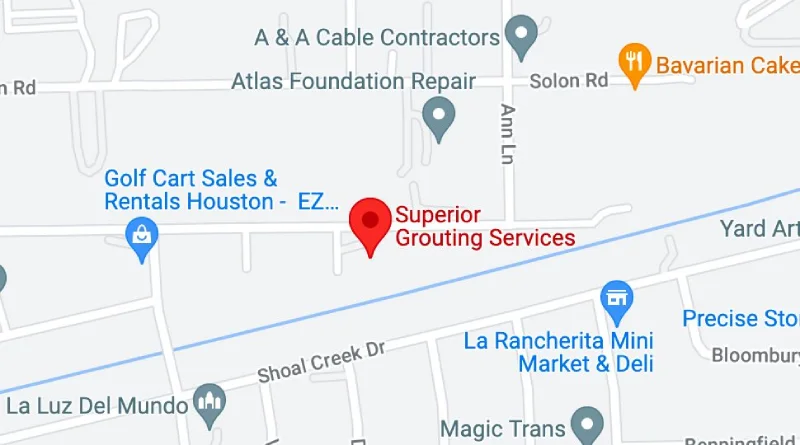Is Polyurethane the Best Fix for Weak Railway Soil?

Polyurethane injection is considered one of the best solutions for stabilizing weak railway soil, particularly when rapid, minimally disruptive, and water-resistant stabilization is required. The expanding foam increases soil strength, fills voids, raises bearing capacity, and controls settlement while being highly effective in high water table areas and problematic ground conditions.
The material expands to bind soil particles and forms a solid mass with increased strength and durability, often outperforming traditional stabilization methods in both short-term response and long-term performance. This makes it ideal for critical railway infrastructure that cannot afford extended downtime.
For Texas railway systems and nationwide rail infrastructure, professional polyurethane grouting provides reliable soil stabilization solutions that maintain operational safety while addressing underlying geotechnical problems effectively.
Key Takeaways
- Polyurethane injection offers superior railway soil stabilization through rapid expansion that binds particles and creates solid, durable masses with increased bearing capacity.
- Minimal disruption installation allows railway operations to continue with reduced downtime and safety risks compared to traditional soil stabilization methods.
- Excellent water resistance makes polyurethane ideal for flood-prone areas, high water table conditions, and embankments subject to erosion or moisture damage.
- Fast installation speed enables emergency repairs and urgent stabilization needs that cannot wait for traditional methods requiring extended construction periods.
- Versatility across different soil types and conditions makes polyurethane effective where other methods may be limited by specific geological requirements.
- Long-term durability provides decades of stable performance while resisting chemical attack, freeze-thaw cycles, and environmental degradation that affects other materials.
How Polyurethane Stabilizes Railway Soil
Polyurethane soil stabilization works through a chemical expansion process that transforms weak, loose soil into a solid, structurally sound foundation capable of supporting railway loads safely.
Expansion and Binding Mechanism
When injected into soil, polyurethane reacts with moisture to expand dramatically, filling voids and binding individual soil particles into a cohesive mass. This process creates immediate stabilization effects that continue improving over time.
According to geotechnical engineering research, polyurethane foam can expand to 20 times its original volume while maintaining structural integrity, making it highly effective for filling large voids in railway subgrade conditions.
Stabilization Process:
- Initial injection fills existing voids and weak zones
- Chemical reaction with soil moisture triggers expansion
- Expanding foam displaces water and binds particles
- Cured material provides permanent structural support
- Final result is significantly increased bearing capacity
Load Distribution and Bearing Capacity
The cured polyurethane creates a uniform load distribution system that prevents localized failure and settlement under railway loading conditions. This distributed support system is critical for maintaining track geometry.
| Soil Condition | Before Treatment | After Treatment | Improvement Factor |
| Bearing Capacity | Variable, often inadequate | Uniform, high capacity | 3-10x increase |
| Settlement Control | Uncontrolled, progressive | Controlled, minimal | 80-95% reduction |
| Load Distribution | Point loading, stress concentration | Distributed loading | Even stress field |
| Void Filling | Open voids, water infiltration | Solid fill, waterproof | Complete elimination |
Water Resistance and Drainage Control
Polyurethane's excellent water resistance properties provide long-term protection against moisture-related soil degradation, which is particularly important for railway applications in Texas where clay soils and seasonal flooding present ongoing challenges.
The material forms an impermeable barrier that prevents water infiltration while maintaining structural integrity under hydrostatic pressure conditions that would compromise other stabilization methods.
Comparison with Traditional Stabilization Methods
Polyurethane injection offers distinct advantages over conventional soil stabilization approaches, particularly for railway applications where operational constraints and performance requirements are demanding.
Speed and Disruption Analysis
Railway operations require stabilization methods that minimize service interruption while providing reliable long-term performance. Polyurethane excels in both areas compared to traditional approaches.
Installation Time Comparison:
- Polyurethane injection: Hours to complete, immediate traffic resumption
- Cement/lime injection: Days to weeks, extended curing periods
- Mechanical compaction: Weeks to months, major excavation required
- Geogrid installation: Weeks to months, complete reconstruction needed
Performance in Water-Affected Soils
Railway embankments and subgrade areas frequently encounter water-related problems that compromise stability. Polyurethane's superior water resistance provides significant advantages over other methods.
According to railway engineering studies, water infiltration is a primary cause of railway soil failure, making waterproof stabilization methods essential for long-term reliability.
Water Resistance Comparison:
- Polyurethane: Excellent waterproofing and chemical resistance
- Cement/lime: Moderate water resistance, susceptible to leaching
- Mechanical methods: Poor water resistance without additional drainage
- Geosynthetics: Good drainage but limited waterproofing capability
Cost-Effectiveness Over Time
While initial material costs may be higher, polyurethane often provides superior long-term value through reduced maintenance requirements and extended service life.
| Method | Initial Cost | Maintenance Frequency | Total Lifecycle Cost | Reliability |
| Polyurethane | Moderate-High | Very Low | Moderate | Excellent |
| Cement/Lime | Moderate | Moderate | Moderate-High | Good |
| Mechanical | High | High | High | Variable |
| Geosynthetics | Moderate | Low-Moderate | Moderate | Good |
Railway-Specific Application Advantages
Railway infrastructure presents unique challenges that make polyurethane particularly well-suited compared to other stabilization approaches.
Operational Continuity Benefits
Railway systems cannot afford extended downtime for soil stabilization work. Polyurethane injection allows repairs and improvements while maintaining operational schedules.
Operational Advantages:
- Installation possible during normal maintenance windows
- No heavy equipment blocking tracks for extended periods
- Immediate return to service after injection completion
- Minimal safety zone requirements during installation
- Emergency response capability for urgent situations
Track Geometry Preservation
Maintaining precise track geometry is critical for safe railway operations. Polyurethane stabilization provides uniform support that prevents differential settlement and track deformation.
Geometry Benefits:
- Prevents differential settlement causing track irregularities
- Maintains consistent support across treatment areas
- Reduces maintenance frequency for track alignment
- Extends rail and tie service life through stable support
- Improves ride quality and operational safety
Load Transfer Efficiency
Railway loads create concentrated stresses that weak soils cannot adequately support. Polyurethane creates efficient load transfer systems that distribute forces safely.
Load Transfer Improvements:
- Converts point loads to distributed area loads
- Eliminates stress concentrations causing localized failure
- Provides consistent support under dynamic loading
- Reduces vibration transmission to adjacent structures
- Maintains performance under repeated load cycles
Environmental and Site-Specific Considerations
Texas railway systems face unique environmental challenges that influence soil stabilization method selection and long-term performance expectations.
Climate and Soil Conditions
Texas clay soils present particular challenges for railway stability due to their expansive nature and sensitivity to moisture changes. Polyurethane's properties address these specific concerns effectively.
Texas-Specific Challenges:
- Expansive clay soils causing seasonal movement
- Extreme temperature variations affecting materials
- Flood-prone areas requiring waterproof solutions
- High water table conditions in coastal regions
- Drought conditions causing soil shrinkage and settlement
Environmental Impact Considerations
Modern polyurethane formulations are designed to minimize environmental impact while providing effective soil stabilization performance over decades of service.
Environmental Benefits:
- No harmful leaching into groundwater systems
- Reduced excavation and material transportation needs
- Lower carbon footprint compared to replacement methods
- Chemical inertness after curing prevents soil contamination
- Recyclable components in some advanced formulations
Regulatory Compliance Factors
Railway soil stabilization projects must comply with federal, state, and local environmental regulations. Polyurethane systems are designed to meet these requirements.
Compliance Advantages:
- EPA-approved formulations for groundwater protection
- Railroad administration acceptance for safety applications
- State environmental permit compatibility
- Minimal documentation requirements for approved materials
- Established track record for regulatory approval
Professional Application and Quality Control
Achieving optimal results with polyurethane railway soil stabilization requires professional expertise in geotechnical assessment, material selection, and application procedures.
Site Assessment and Testing
Comprehensive geotechnical evaluation determines the appropriate polyurethane approach for specific soil conditions and railway loading requirements.
Assessment Components:
- Soil classification and strength testing
- Groundwater level and flow analysis
- Railway loading and traffic pattern evaluation
- Environmental condition assessment
- Access and safety requirement determination
Injection Procedures and Equipment
Professional-grade injection equipment ensures proper material placement and optimal expansion characteristics for effective soil stabilization.
Equipment Requirements:
- High-pressure injection pumps for deep penetration
- Flow control systems for precise material placement
- Monitoring equipment for quality control verification
- Safety equipment for railway environment work
- Environmental protection systems as needed
Quality Control and Performance Verification
Professional installation includes comprehensive quality control measures that verify stabilization effectiveness and predict long-term performance.
Verification Methods:
- Pre-treatment soil testing and condition documentation
- Real-time monitoring during injection and expansion
- Post-treatment load testing and settlement monitoring
- Long-term performance tracking and evaluation
- Warranty programs backing stabilization effectiveness
Limitations and Site-Specific Considerations
While polyurethane is highly effective for railway soil stabilization, certain conditions may require modified approaches or complementary techniques for optimal results.
Soil Type Considerations
Different soil types respond differently to polyurethane injection, with some conditions requiring specialized approaches for optimal stabilization results.
Soil-Specific Factors:
- Highly organic soils may require pre-treatment
- Extremely dense soils may limit penetration depth
- Contaminated soils may affect chemical reactions
- Very fine soils may require pressure management
- Rock formations may need mechanical preparation
Project Scale and Economics
Large-scale railway construction projects may benefit from combination approaches using polyurethane for critical areas and traditional methods for bulk stabilization.
Scale Considerations:
- Small repair areas favor polyurethane advantages
- Large new construction may justify traditional methods
- Emergency repairs strongly favor rapid polyurethane response
- Maintenance programs benefit from polyurethane flexibility
- Budget constraints may influence method selection
Long-Term Monitoring Needs
Even successful polyurethane stabilization benefits from ongoing monitoring to verify continued effectiveness and detect any new issues requiring attention.
Monitoring Requirements:
- Regular track geometry surveys for settlement detection
- Periodic geotechnical testing for stability verification
- Environmental monitoring for groundwater protection
- Visual inspection for surface condition changes
- Performance documentation for maintenance planning
Selection Criteria for Optimal Results
Choosing polyurethane for railway soil stabilization requires evaluation of multiple factors to ensure the best outcome for specific project requirements and constraints.
Project Requirement Analysis
Understanding specific project goals helps determine whether polyurethane offers the best solution compared to alternative stabilization methods.
Decision Factors:
- Time constraints and operational windows available
- Performance requirements and expected service life
- Environmental conditions and regulatory constraints
- Budget limitations and lifecycle cost considerations
- Access restrictions and safety requirements
Professional Consultation Benefits
Working with experienced grouting services ensures proper evaluation of site conditions and optimal method selection for railway soil stabilization projects.
Professional Services Include:
- Comprehensive geotechnical assessment and analysis
- Method comparison and recommendation development
- Material specification and application planning
- Quality control during installation and curing
- Long-term performance monitoring and support
Conclusion
Polyurethane injection represents one of the best solutions for railway soil stabilization due to its rapid installation, minimal operational disruption, excellent water resistance, and long-term durability. The method excels particularly when time constraints, operational continuity, and water-related soil problems make traditional approaches impractical.
Success depends on proper site assessment, correct material selection, professional installation procedures, and appropriate quality control verification. While other methods may be suitable for specific applications, polyurethane offers unique advantages that make it ideal for most railway soil stabilization needs.
Superior Grouting provides expert railway soil stabilization services using advanced polyurethane injection techniques tailored to specific site conditions and operational requirements. For professional evaluation of your railway soil stabilization needs, contact our experienced geotechnical team.

